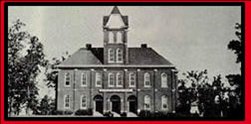
Mission Statement
The mission of Bowdon High School is to prepare students to excel in a global world.
The History of Bowdon High School
The first school in Bowdon was established in 1854, and by 1855 there was both a primary school and a high school. The school's first teacher was William W. Fitts originally from Elbert County, Georgia. Boys and girls of all ages were taught in the old academy located just a few hundred feet from the current school campus. The academy had been conveniently located by a spring at the foot of the hill just northeast of the current Bowdon Area Historical facility (formerly the Methodist Protestant Church). When Bowdon College was founded in 1857 a unique and close relationship with the high school began. In 1859 a two story wooden facility was constructed for the college. When the War Between the States began students and professors alike marched off to join Cobb's Legion, and the college doors were closed from 1861 to 1867. During this time A.C. Reese conducted a preparatory school in the college facility. When the cotton market collapsed in 1914, the financial crisis again caused the college to close from 1915 to 1919. During these years, the high school was again housed in the college facility which was now a beautiful two-story brick structure built in 1901 by local effort.
A 1918 report of the Carroll County Schools lists Bowdon High School as located on four acres of land surrounded by a large grove of trees and large playgrounds. The school building was valued at $20,000 with nine classrooms and an auditorium. The equipment listed included single and double patent desks, cloth blackboards, and a few maps. There were ten teachers and 229 pupils in twelve grades. Maintenance funds from the county were $1560.00. When the college reopened, the need for a separate facility became paramount. City leaders purchased land from E. C. Burns Sr. on East College Street where Crossroads Academy is now located. The cornerstone for the orange brick building was laid on December 9, 1921, and the first classes were held in the building in September of 1923. Ten teachers worked with 300 pupils in grades one through nine. Tenth and eleventh graders were initially housed at Bowdon College. Tuition for all public school grades was $7.00 for nine months with half due each semester, but provisions were made for those who could not afford to pay. Books were purchased by students. Seats for the auditorium were purchased by the PTA in 1925, making a seating capacity of 400.
The enrollment grew to 350 when the tenth grade was added in 1926 and to 400 when the eleventh grade was moved to the new facility in 1927. The addition of a science laboratory on the east wing brought accreditation to the school. In 1928 bus transportation was added to transport 111 students. There were 352 students who walked to school and ten boarding students. Classes were held from 8:00 a.m. until noon with an hour for lunch. Students within walking distance were allowed to go home for lunch before the afternoon classes continued until 3:30 p.m.
U.S. Congressman Charles Adamson, a Bowdon College graduate, acquired World War I cannons for the school campus. For years they were mounted under the trees on the front lawn. When Bowdon College closed in 1936, the high school was moved to the former college facility. Statewide the twelfth grade was added in the fall of 1951. A wooden gymnasium was built after World War II by veterans, but it burned in October of 1954 and was replaced by Ava Sewell Hall which was built totally by local donation and labor. A bond issue passed in 1958 built the current Bowdon High School as well as Villa Rica High and Central High. Students first entered the current building in January of 1959. The first addition to the school was added in 1965. In the 1972-73 school year students began using a new library and a seven classroom addition. A later bond issue in 1974 built a new agriculture and band facility. In the 2002-03 school year, HS went through a multi-million dollar renovation project. During these renovations a new office complex was added to the school, and a new greenhouse for the agriculture department was added as well. The lovely Bowdon College building was torn down in 1961, but a bell tower with the original college bell marks the spot of the former college.
Bowdon High School has a rich tradition of academics as fostered by its early association with Bowdon College.
